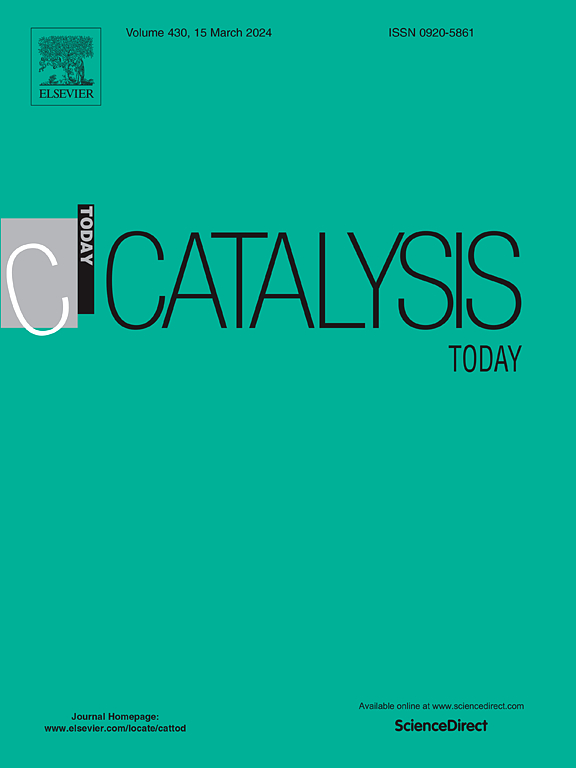Efficient hydrodeoxygenation of used cooking oil using molybdenum phosphide on silica supports for sustainable green fuel production
IF 5.2
2区 化学
Q1 CHEMISTRY, APPLIED
引用次数: 0
Abstract
This study investigated the catalytic hydrotreatment of triglycerides using molybdenum phosphide (MoP) supported on different silica-based materials and evaluated their performance in hydrodeoxygenation (HDO) reactions. The catalysts were synthesized using the phosphite method and characterized using techniques such as X-ray diffraction (XRD), nitrogen adsorption‒desorption isotherms, temperature‒programmed desorption (NH3-TPD), transmission electron microscopy (TEM), and Raman spectroscopy. Catalytic activity tests were conducted using methyl laurate (ML) and glyceryl trioleate (GLY) as model compounds, as well as used cooking oil (UCO). This study examined the effect of different supports, including silica and silica-alumina with varying pellet morphologies (cylinder and trilobe), on the catalytic performance. The results showed that MoP supported on trilobe silica (MoP/SiO2-t) exhibited the highest conversion rates, selectivity for hydrocarbons, and long-term stability over 100 h. The catalyst demonstrated superior deoxygenation efficiency, effectively reducing oxygenated intermediates. Compared with glyceryl trioleate, used cooking oil resulted in greater conversion due to the presence of additional reactive compounds. These findings highlight MoP/SiO2-t as a viable catalyst for scaling up sustainable biofuel production.
利用二氧化硅支架上的磷化钼对废食用油进行高效加氢脱氧,实现可持续的绿色燃料生产
研究了不同硅基材料负载磷化钼(MoP)对甘油三酯的催化加氢处理,并评价了其在加氢脱氧(HDO)反应中的性能。采用亚磷酸酯法合成催化剂,并利用x射线衍射(XRD)、氮气吸附-脱附等温线、程序升温脱附(NH3-TPD)、透射电镜(TEM)和拉曼光谱等技术对催化剂进行了表征。以月桂酸甲酯(ML)和三油酸甘油酯(GLY)为模型化合物,以及废食用油(UCO)进行了催化活性测试。本研究考察了不同载体对催化性能的影响,包括具有不同颗粒形态(圆柱形和三叶状)的二氧化硅和二氧化硅-氧化铝。结果表明,三叶二氧化硅负载的MoP (MoP/SiO2-t)具有最高的转化率、对烃类的选择性和在100 h以上的长期稳定性。该催化剂表现出优异的脱氧效率,能有效地还原氧化中间体。与三油酸甘油相比,使用过的食用油由于存在额外的活性化合物而导致更高的转化率。这些发现强调了MoP/SiO2-t是扩大可持续生物燃料生产的可行催化剂。
本文章由计算机程序翻译,如有差异,请以英文原文为准。
求助全文
约1分钟内获得全文
求助全文
来源期刊

Catalysis Today
化学-工程:化工
CiteScore
11.50
自引率
3.80%
发文量
573
审稿时长
2.9 months
期刊介绍:
Catalysis Today focuses on the rapid publication of original invited papers devoted to currently important topics in catalysis and related subjects. The journal only publishes special issues (Proposing a Catalysis Today Special Issue), each of which is supervised by Guest Editors who recruit individual papers and oversee the peer review process. Catalysis Today offers researchers in the field of catalysis in-depth overviews of topical issues.
Both fundamental and applied aspects of catalysis are covered. Subjects such as catalysis of immobilized organometallic and biocatalytic systems are welcome. Subjects related to catalysis such as experimental techniques, adsorption, process technology, synthesis, in situ characterization, computational, theoretical modeling, imaging and others are included if there is a clear relationship to catalysis.
 求助内容:
求助内容: 应助结果提醒方式:
应助结果提醒方式:


